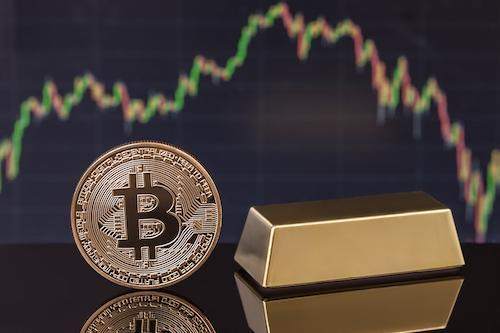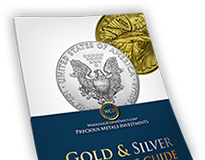
Has Reality Caught Up with Overhyped Bitcoin? Could Gold Benefit?
Readers of this blog have probably been aware for some time that this writer is no fan of Bitcoin – in fact, quite the opposite. My view is that the cryptocurrency has no substance behind it and that at least some of the Bitcoin sales and marketing sector is run by individuals with, to say the least, unsavory backgrounds that would imply they are attracted to get-rich-quick schemes. Thus, some of the key companies involved in the sales, marketing, and handling of cryptocurrencies may potentially be fraudulent in their make-ups and promotional activities. Could it be that some of the huge paper gains seen in the Bitcoin arena are less than real? There certainly seems to be ever increasing evidence that some of the biggest players in the cryptocurrency sector are perhaps entities with dubious financial antecedents. Additionally, what may be seen as encouraging for Bitcoin skeptics is that the regulatory sector seems, at long last, to be taking action against some of them.
It’s not necessarily that Bitcoin, and cryptocurrencies in general, is itself a dishonest idea. Indeed, the concept is probably sound, although some of the apparent, huge, and rapid price gains seen recently seem to be more than suspicious. Some of those players persuaded to set up entities aimed at controlling the market boast, at the very least, the kind of dubious financial backgrounds often rife with suspect financial dealings that take place at the expense of investors. These players now seem prepared to exploit these same investors in the crypto space.
Of course, investor greed plays a hugely significant role in the Bitcoin price story. In the same way that Ponzi scheme investors may be sucked in by seemingly too-good-to-be-true investment returns and gains, so, too, have Bitcoin investors been mesmerized by prospectively massive price advances – that have, of course, been heavily promoted, and possibly manipulated. But when it comes to cashing in on these paper gains, some investors – but not all – seem to be finding it virtually impossible to do so. There are legitimate players in the sector, but the problem facing the investor is sorting the wheat from the chaff, and the Internet, with its plethora of conflicting and often dubious claims, helps make this sometimes extremely difficult to do.
The rapidly advancing price of Bitcoin in the first half of the year should have set investor alarm bells ringing, although most seemed more than happy to go along with the ride. Some commentators fed the cryptocurrency buying frenzy by predicting that Bitcoin (BTC), currently the most popular crypto, would rise to $1 million – surely a hugely overhyped pipe dream, and perhaps even way more unlikely than those predictions touting $10,000 gold!
On the contrary, BTC has repaid investors by halving paper values over the past couple of months. We suggest the price of BTC and other cryptos could fall even farther in the months ahead, as regulatory evidence demonstrates that the claims of some of the biggest players in the market are, at best, dubious, and quite possibly criminal.
Grant Williams, in his always perceptive and entertaining, “Things that make you go hmmm...” newsletter, published a recent article on this topic, titled, Schrödinger’s Coin, which he released as an accompaniment to an episode of his subscriber-only podcast that he recorded with Bennett Tomlin and George Noble. Both of these financial experts put forward what appears to be definitive proof of the fraudulent antecedents of some of those who control at least two of the biggest entities in the Bitcoin sector, plus companies with which they may be associated. It should be noted that neither Tomlin nor Noble are Bitcoin skeptics per se, but they are both hugely critical of at least two of these biggest players that the podcast focuses on.
The most widely traded cryptocurrency token, BTC, has, as noted above, more than halved in value from its peak over the past few weeks. While the price was climbing sharply, there was media advice for investors to replace their safe-haven gold holdings with Bitcoin, following, in our view, often misguided or perhaps biased encouragement, often offered by parties who would gain from such transitions to crypto from precious metals. Those who succumbed to this near the BTC price top will have had their fingers very severely burnt. Maybe they will return to gold, if they have any resources left to do so after the huge falls in BTC’s price (and that of most other cryptocurrencies).
Even though gold has been a somewhat lackluster performer over the current year so far, it has at least pretty much retained its value year to date. Prospects for its price growth look, to this observer, like they will remain good in this time of rising inflation, which is coinciding with the world beginning to exit from pandemic related economic slowdowns. Meanwhile, some of the mud being thrown at Bitcoin that casts doubts on it being a safe and potentially hugely profitable investment will surely stick. Also, likely increasing interference in the crypto market by governments and regulators who see it as a threat to their fiscal and taxation systems, and their utilization by criminal elements to hold and transfer monies in a virtually untraceable manner, will also have a negative impact on Bitcoin’s and other cryptocurrencies’ future performances. Gold, to this writer, definitely looks to be a better, safer, and more ethical long-term wealth protector. Bitcoin could conceivably rise again, but we think the reverse is more likely to come about over time, as some of the more unsavory aspects of the crypto world are increasingly being exposed.
As to the gold price, its performance over the past week has been somewhat erratic, as has our trying to predict any real sense of short-term direction. Movement this week may help define its likely path. Gold started the past week below $1,800 and spent most of the midweek in the $1,820s, before being brought down to around $1,812 by the week’s end. As usual, it was primarily driven by data releases taken as positive or negative for the yellow metal. We, however, view the overall trend as positive, given it managed to end the week well above $1,800.
Silver and the Platinum Group Metals (PGMs) fared even worse, with the former ending the week well below $26, pushing the Gold:Silver ratio back above 70 for the first time in a number of weeks. PGMs were, no doubt, affected by something of a slump in U.S. new car sales. Looking ahead, we see gold rising towards the $1,850s and silver picking up a little, too, while industrial metals like the PGMs are likely to be more affected by the vagaries of the U.S. economy. With the Federal Reserve apparently ruling out any tapering of its current financial policies for the foreseeable future, while inflation may be taking and increasing its hold on the U.S. economy (even if, as Fed Chair Powell expects, this phenomenon will cool down fairly rapidly), gold looks set to gain a fair amount given real interest rates look more negative by the day.






